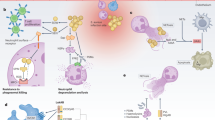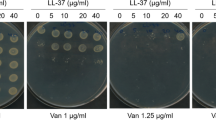Abstract
Methicillin-resistant Staphylococcus aureus (MRSA) remains a major human pathogen. Traditionally, MRSA infections occurred exclusively in hospitals and were limited to immunocompromised patients or individuals with predisposing risk factors. However, recently there has been an alarming epidemic caused by community-associated (CA)-MRSA strains, which can cause severe infections that can result in necrotizing fasciitis or even death in otherwise healthy adults outside of healthcare settings1,2. In the US, CA-MRSA is now the cause of the majority of infections that result in trips to the emergency room3. It is unclear what makes CA-MRSA strains more successful in causing human disease compared with their hospital-associated counterparts. Here we describe a class of secreted staphylococcal peptides that have a remarkable ability to recruit, activate and subsequently lyse human neutrophils, thus eliminating the main cellular defense against S. aureus infection. These peptides are produced at high concentrations by standard CA-MRSA strains and contribute significantly to the strains' ability to cause disease in animal models of infection. Our study reveals a previously uncharacterized set of S. aureus virulence factors that account at least in part for the enhanced virulence of CA-MRSA.
This is a preview of subscription content, access via your institution
Access options
Subscribe to this journal
Receive 12 print issues and online access
$209.00 per year
only $17.42 per issue
Buy this article
- Purchase on Springer Link
- Instant access to full article PDF
Prices may be subject to local taxes which are calculated during checkout




Similar content being viewed by others
Accession codes
Change history
27 November 2007
In the version of this article initially published online, the PSMα peptide presented as a helical wheel in Figure 4e is PSMα4, not PSMα3 as stated in the figure and in the legend. The error has been corrected for all versions of the article.
References
Miller, L.G. et al. Necrotizing fasciitis caused by community-associated methicillin-resistant Staphylococcus aureus in Los Angeles. N. Engl. J. Med. 352, 1445–1453 (2005).
Chambers, H.F. Community-associated MRSA–resistance and virulence converge. N. Engl. J. Med. 352, 1485–1487 (2005).
Moran, G.J. et al. Methicillin-resistant S. aureus infections among patients in the emergency department. N. Engl. J. Med. 355, 666–674 (2006).
Baba, T. et al. Genome and virulence determinants of high virulence community-acquired MRSA. Lancet 359, 1819–1827 (2002).
Diep, B.A. et al. Complete genome sequence of USA300, an epidemic clone of community-acquired methicillin-resistant Staphylococcus aureus. Lancet 367, 731–739 (2006).
Vandenesch, F. et al. Community-acquired methicillin-resistant Staphylococcus aureus carrying Panton-Valentine leukocidin genes: worldwide emergence. Emerg. Infect. Dis. 9, 978–984 (2003).
Gillet, Y. et al. Association between Staphylococcus aureus strains carrying gene for Panton-Valentine leukocidin and highly lethal necrotising pneumonia in young immunocompetent patients. Lancet 359, 753–759 (2002).
Grojec, P.L. & Jeljaszewicz, J. Effect of staphylococcal leukocidin on mouse leukocyte system. Zentralbl. Bakteriol. Mikrobiol. Hyg. [A] 250, 446–455 (1981).
Cribier, B. et al. Staphylococcus aureus leukocidin: a new virulence factor in cutaneous infections? An epidemiological and experimental study. Dermatology 185, 175–180 (1992).
Labandeira-Rey, M. et al. Staphylococcus aureus Panton-Valentine leukocidin causes necrotizing pneumonia. Science 315, 1130–1133 (2007).
Fridkin, S.K. et al. Methicillin-resistant Staphylococcus aureus disease in three communities. N. Engl. J. Med. 352, 1436–1444 (2005).
Voyich, J.M. et al. Is Panton-Valentineleukocidin the major virulence determinant in community-associated methicillin-resistant Staphylococcus aureus disease? J. Infect. Dis. 194, 1761–1770 (2006).
Mehlin, C., Headley, C.M. & Klebanoff, S.J. An inflammatory polypeptide complex from Staphylococcus epidermidis: isolation and characterization. J. Exp. Med. 189, 907–918 (1999).
Voyich, J.M. et al. Insights into mechanisms used by Staphylococcus aureus to avoid destruction by human neutrophils. J. Immunol. 175, 3907–3919 (2005).
Adem, P.V. et al. Staphylococcus aureus sepsis and the Waterhouse-Friderichsen syndrome in children. N. Engl. J. Med. 353, 1245–1251 (2005).
Kravitz, G.R., Dries, D.J., Peterson, M.L. & Schlievert, P.M. Purpura fulminans due to Staphylococcus aureus. Clin. Infect. Dis. 40, 941–947 (2005).
Mellor, I.R., Thomas, D.H. & Sansom, M.S. Properties of ion channels formed by Staphylococcus aureus delta-toxin. Biochim. Biophys. Acta 942, 280–294 (1988).
Kong, K.F., Vuong, C. & Otto, M. Staphylococcus quorum sensing in biofilm formation and infection. Int. J. Med. Microbiol. 296, 133–139 (2006).
Redfield, R.J. Is quorum sensing a side effect of diffusion sensing? Trends Microbiol. 10, 365–370 (2002).
Holden, M.T. et al. Complete genomes of two clinical Staphylococcus aureus strains: evidence for the rapid evolution of virulence and drug resistance. Proc. Natl. Acad. Sci. USA 101, 9786–9791 (2004).
Gill, S.R. et al. Insights on evolution of virulence and resistance from the complete genome analysis of an early methicillin-resistant Staphylococcus aureus strain and a biofilm-producing methicillin-resistant Staphylococcus epidermidis strain. J. Bacteriol. 187, 2426–2438 (2005).
Kuroda, M. et al. Whole genome sequencing of meticillin-resistant Staphylococcus aureus. Lancet 357, 1225–1240 (2001).
Diep, B.A., Carleton, H.A., Chang, R.F., Sensabaugh, G.F. & Perdreau-Remington, F. Roles of 34 virulence genes in the evolution of hospital- and community-associated strains of methicillin-resistant Staphylococcus aureus. J. Infect. Dis. 193, 1495–1503 (2006).
Vuong, C., Gotz, F. & Otto, M. Construction and characterization of an agr deletion mutant of Staphylococcus epidermidis. Infect. Immun. 68, 1048–1053 (2000).
Bae, T. & Schneewind, O. Allelic replacement in Staphylococcus aureus with inducible counter-selection. Plasmid 55, 58–63 (2006).
Novick, R.P. et al. Synthesis of staphylococcal virulence factors is controlled by a regulatory RNA molecule. EMBO J. 12, 3967–3975 (1993).
Peschel, A., Ottenwalder, B. & Gotz, F. Inducible production and cellular location of the epidermin biosynthetic enzyme EpiB using an improved staphylococcal expression system. FEMS Microbiol. Lett. 137, 279–284 (1996).
Acknowledgements
We thank B. Diep and H. Chambers (University of California, San Francisco, USA) for S. aureus strains, T. Bae and O. Schneewind for plasmid pKOR1 (University of Chicago, Chicago, USA) and M. Teintze for help with circular dichroism measurements. This work was supported by the Intramural Research Program of the National Institute of Allergy and Infectious Diseases, US National Institutes of Health (to M.O. and F.R.D.) and the German Research Council (SFB 685) and the German Ministry of Education and Research (to A.P.).
Author information
Authors and Affiliations
Contributions
M.O. isolated and identified the PSM peptides and performed HPLC/MS, D.K. performed chemotaxis experiments, R.W. and K.R.B. performed neutrophil lysis experiments, T.-H.L.B. performed bacterial growth curves, R.W., S.Y.Q. and M.L. performed animal experiments, R.W. and S.Y.Q. performed circular dichroism experiments, R.W. and A.D.K. performed flow cytometry, D.W.D. performed electron microscopy, and R.W. performed all other experiments. S.J.K., A.P., F.R.D. and M.O. supervised the experiments and M.O. prepared the manuscript.
Corresponding author
Supplementary information
Supplementary Text and Figures
Supplementary Figs. 1–6 and Supplementary Methods (PDF 10335 kb)
Rights and permissions
About this article
Cite this article
Wang, R., Braughton, K., Kretschmer, D. et al. Identification of novel cytolytic peptides as key virulence determinants for community-associated MRSA. Nat Med 13, 1510–1514 (2007). https://doi.org/10.1038/nm1656
Received:
Accepted:
Published:
Issue Date:
DOI: https://doi.org/10.1038/nm1656
This article is cited by
-
Deciphering agr quorum sensing in Staphylococcus aureus: insights and therapeutic prospects
Molecular Biology Reports (2024)
-
Modulation of MRSA virulence gene expression by the wall teichoic acid enzyme TarO
Nature Communications (2023)
-
Staphylococcal virulence factor HlgB targets the endoplasmic-reticulum-resident E3 ubiquitin ligase AMFR to promote pneumonia
Nature Microbiology (2023)
-
Antibiotic treatment can exacerbate biofilm-associated infection by promoting quorum cheater development
npj Biofilms and Microbiomes (2023)
-
A monocyte–leptin–angiogenesis pathway critical for repair post-infection
Nature (2022)



